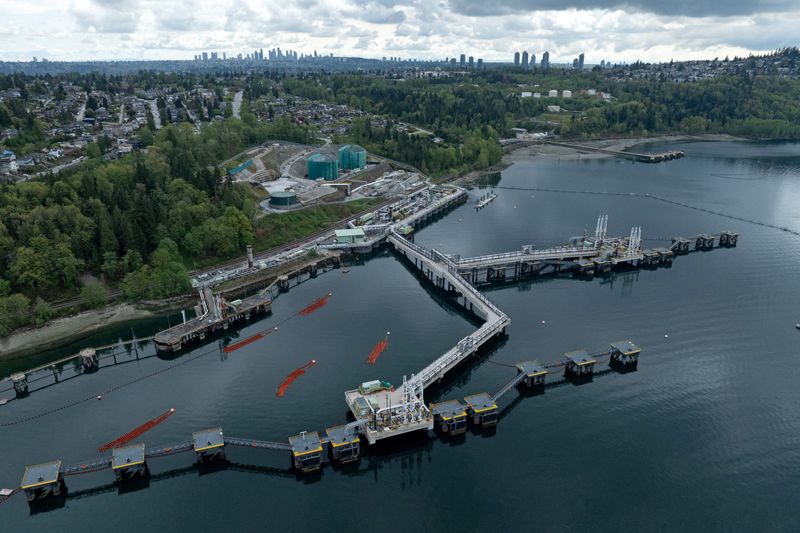
By Nia Williams
(Reuters) – Canada’s Trans Mountain oil pipeline will rely heavily on last-minute shippers to turn a profit, the corporation’s financial projections show, clouding Ottawa’s efforts to sell the pipeline now that its C$34.2 billion ($25.04 billion) expansion is finished after years of delays.
Documents filed by Trans Mountain as part of a regulatory dispute over its tolls show it could take up to eight years to make money unless the pipeline fills thousands of barrels a day of uncommitted shipping space.
Trans Mountain said it expects the pipeline will be highly utilized as Canadian production grows, but some traders and analysts warn that will be challenging given higher tolls and logistical constraints at the Port of Vancouver, where the pipeline ends.
The 890,000 barrel-per-day (bpd) pipeline started service in May and reserves 20% of its space for uncommitted, or spot, customers, who pay higher tolls than shippers with long-term contracts.
Documents filed with Canadian regulators in April show different utilization scenarios for that 178,000 bpd of spot capacity.
In a scenario with zero spot shipments, the pipeline would not generate positive equity return – earnings after depreciation, interest and taxes are subtracted – until 2031. If, as Trans Mountain forecasts, the pipe runs 96% full from next year, equity return turns positive in 2026.
This month, a Trans Mountain executive told Reuters a “little bit” of spot capacity is being used. Mark Maki, Trans Mountain’s chief financial officer, said spot capacity was important to the company’s overall economics and he expected volumes to rise late in the year.
But spot-shipping demand is difficult to forecast because it relies on the fluctuating price of Canadian oil versus other heavy crudes in the U.S. and Asian markets, said Morningstar analyst Stephen Ellis.
He described Trans Mountain’s long-term forecast for 96% utilization as aggressive.
“One of their biggest Achilles’ heels is the reliance on spot,” said Robyn Allan, an independent economist who has studied Trans Mountain’s finances. “Everything is based on a very optimistic set of projections for the next 20 years.”
The rival Enbridge (NYSE:ENB) Mainline, which takes crude to the U.S. Midwest and eastern Canada, offers 100% spot capacity but tolls are roughly half Trans Mountain’s rate. TC Energy (NYSE:TRP)’s Keystone pipeline to the U.S. reserves around 10% spot capacity.
One Canadian crude trader said spot demand for Trans Mountain would depend on how full rival pipelines are.
Canada Development Investment Corporation (CDEV), the government corporation that owns Trans Mountain, noted in May 2023 that higher tolls may deter customers.
“Forecast tolls for pipeline transportation are higher due to (the expansion’s) cost escalation and have lessened competitive advantages,” CDEV said.
Costs surged during construction to nearly five times the 2017 budget and sparked a backlash from committed shippers including Suncor Energy (NYSE:SU) and Canadian Natural (NYSE:CNQ) Resources, who face higher-than-expected tolls as a result.
One mountainous segment soared from an estimated C$377 million in 2017 to C$4.6 billion in 2023 after hitting technical difficulties. Other segments passing through Metro Vancouver jumped from C$310 million to C$1.7 billion over the same period.
NO HURRY TO SELL
Prime Minister Justin Trudeau’s government bought Trans Mountain in 2018 to ensure the expansion, which has nearly tripled shipping capacity from Alberta to the Pacific coast, proceeded.
However Ottawa never intended to be the long-term owner and Canada’s Finance Ministry said it is planning a sales process.
Spokeswoman Katherine Cuplinskas said the expansion was an important economic investment, creating revenues and well-paying jobs.
Maki urged Ottawa not to hurry the sale given uncertainties over spot demand, the tolling dispute, and Ottawa’s plan to sell a stake to Indigenous communities.
“If you’re trying to sell something, and you have uncertainties, it’s going to affect the value someone’s going to pay for it,” Maki said.
Trans Mountain has borrowed C$17 billion from the Canadian government and has a C$19-billion syndicated loan facility from commercial banks. The April financial projections show it could pay more than C$1 billion in interest annually until 2032, although that will depend on interest rates and the corporation’s future capital structure.
Morningstar’s Ellis said even Trans Mountain’s best-case projections show the pipeline will only generate around 8% return on equity by 2034, which he described as the minimum acceptable level for a quality Canadian midstream asset.
Trans Mountain’s debt-to-EBITDA ratio, a measure of how well a company can cover its debts, starts at 11.6 in 2025 and remains above the typical level of 3.5 for a midstream firm until 2040, he said.
“If this was not a government-owned entity the market would have a really hard time supporting it. Those leverage ratios are like junk,” Ellis said.
Trans Mountain said interest payments will likely be reduced if the corporation is recapitalized, and it is working with the government on optimizing its financing plan.
Many analysts say Ottawa will need to take a discount on its investment to make Trans Mountain appealing.
Pembina Pipeline (NYSE:PBA) Corp, the only listed company to publicly express interest in buying Trans Mountain, recently said there was still too much uncertainty. Indigenous groups are also awaiting more clarity.

“Until the tolls are resolved, it will indeed be challenging to move forward with the sale of the pipeline,” said Stephen Mason, CEO of Project Reconciliation, an Indigenous-led group that wants to bid for a stake in Trans Mountain.
($1 = 1.3702 Canadian dollars)
This post is originally published on INVESTING.


